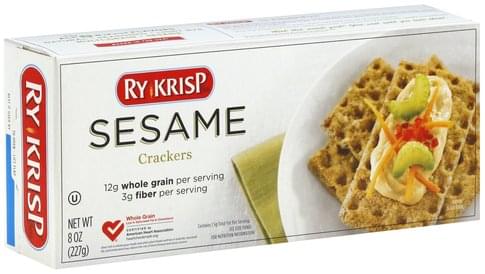

In the late 1930s, Ry-Krisp made an even more dramatic marketing twist.

“For relief eat Ry-Krisp,” it suggested, noting that the crackers were “recommended by physicians for disorders of the digestive tract.” By the 1920s, there was new evidence about the health advantages of whole grains, and Ry-Krisp’s high-fiber ingredients were stressed in its none-too-subtle print ads. Louis-based Ralston Purina purchased Ry-Krisp in 1926, and the cracker’s marketing focus shifted. In 1922, the new owner built the factory where the crackers were made until production came to a stop this month. Ry-Krisp’s creator sold his recipe, baking technique and trademark to a Minneapolis businessman in 1919. For the second and third generations, it’s a taste that reminds us of our grandparents, when they would pull some out to eat with pickled herring.” “Immigrants ate it every day - it was a taste that reminded them of home. “Crispbreads were part of the daily diet for thousands of years, eaten out of necessity,” she said. Nordic food writer, teacher and historian Patrice Johnson said traditional crispbreads - known as knäckebröd by the Swedes, knekkebrød by the Norwegians and knækbrød by the Danes - were popular in the old country because they were cheap, filling and kept well during long winters. Ads for disc-shaped Ry-Krisp showed up in immigrant newspapers printed in native Nordic languages. The first Ry-Krisp was round with a hole in the center, keeping with the Scandinavian tradition of drying crispbreads on a pole. “It was when people first started baking less and buying more of what was ready-made.” “This was around the time that a lot of flour millers were creating new consumer products,” said Dave Stevens, historian and program manager at the Mill City Museum in downtown Minneapolis. Peterson, his brother and widowed mother first sold the crackers door-to-door, then offered it at their bakery in south Minneapolis and registered the trademark for Ry-Krisp in 1905. According to the Minnesota Historical Society’s “Minnesota Encyclopedia” (“The Long Shelf Life of Ry-Krisp”), Swedish immigrant Arvid Peterson created the crackers, milling rye kernels to create the signature “krisp” texture. It was in this era that Ry-Krisp was invented. Minneapolis had become internationally known for its milling innovations by the turn of the last century. When companies change hands, heritage goes out the window.” A new buyer is not invested in the product, so it’s easy to let it go. “Heritage brands can find a niche, but positioning them is expensive and requires thought. “The problem with older brands is they become irrelevant,” John said. Ry-Krisp’s demise does not surprise George John, marketing professor at the University of Minnesota’s Carlson School of Management.

“The brand is no longer a strategic fit for our portfolio.” The Nebraska food conglomerate acquired Ry-Krisp in 2013 the brand was just one piece of a massive deal to purchase the food holdings of Ralcorp, a descendant of Ralston Purina.
Rye krisp crackers cracker#
“The rye cracker category has declined in recent years, and sales of Ry-Krisp have fallen,” said Daniel Hare, a spokesman for ConAgra. I started eating them during camping trips, and now I like a nice stack with cheese and cucumbers.”īut there simply weren’t enough like-minded fans to keep the product in the profit column. Ry-Krisp was always around, but I had to mature into liking it. “I groaned out loud when I heard the factory was closing. Olaf College grew up seeing Ry-Krisp on the table or in the pantry. “What am I going to do without my cardboard crackers?” said Nels Thompson, 22, of Edina. The crunchy rye-flavored snack became an emblem for overlapping culinary trends, shifting from peasant fare to health food to diet aid until changing tastes led to the cracker’s quiet demise. In one short century, Ry-Krisp rose from humble origins to become a product distributed around the globe. Soon the final packages of Ry-Krisp will disappear forever from the cracker aisles, and with them, a bit of local history will crumble. Production at the boxy white factory wound down in March. Every one of the commercially produced crackers inside was mixed, baked and packed at the world’s one and only Ry-Krisp plant in southeast Minneapolis.īut the Minnesota-born brand is no more. For as long as there have been modern grocery stores, there have been boxes of Ry-Krisp on their shelves.


 0 kommentar(er)
0 kommentar(er)
